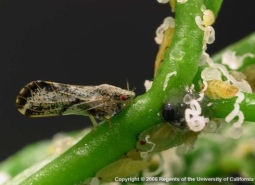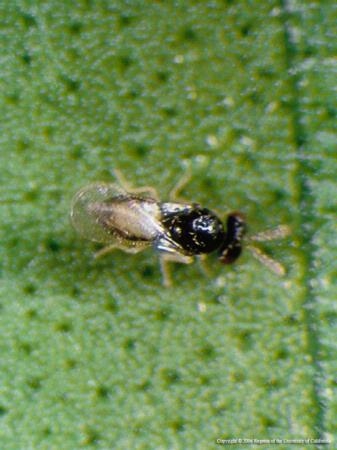Extension Specialist in Biological Control, Department of Entomology, University of California Riverside, CA 92521mark.hoddle@ucr.edu
Well, what a dramatic title, and it is certainly an unabashed rip off from Winston Churchill too! However, many growers in California view the threat posed to the long term viability and profitability of citrus by Asian citrus psyllid (ACP) and huanglongbing (HLB) as a war! ACP is a small sap sucking insect that is native to the Indian subcontinent and it has emerged as a global threat to citrus because it vectors a bacterium (Candidatus Liberibacter asiaticus [CLas]) that causes a lethal and incurable citrus disease, huanglongbing (sometimes referred to as citrus greening). Trees displaying HLB go into decline and some varieties may die in as little as 5-8 years post-infection. Symptoms may include chlorotic leaves (Fig. 2) and premature fruit drop. Fruit that are retained become misshapen as they develop, ripen irregularly (hence the common name citrus greening), and have a bitter taste. Florida's “war” with ACP and HLB started around 1998 when the psyllid was first found, then in 2005 the first citrus trees with HLB symptoms were discovered. Some economic estimates of the ACP-CLas epidemic in Florida suggest that more than 8,000 jobs have been lost, production has declined by 23%, and revenues have dropped by 16% .
ACP was first detected in southern California in 2008, and in 2012, the first citrus trees with HLB symptoms were found in Hacienda Heights in Los Angeles County. Subsequently, HLB has been confirmed in San Gabriel, also in LA County. Detections of ACP in the San Joaquin Valley (SJV) are increasing, especially around Bakersfield, and these finds make the largest citrus production areas in California highly vulnerable to CLas. One response to the ACP invasion has been to go after the vector in urban residential areas where ACP enjoys a relatively good life on backyard citrus trees that are treated infrequently with pesticides. The intention of this urban-residential-ACP control program was to knock back psyllid numbers to low levels with the goal of reducing the rate of spread of ACP and CLas through urban areas and into commercial citrus production zones. Vector reduction have been attempted in two different ways; spraying insecticides and biological control. The California Department of Food and Agriculture aggressively pursued residential spraying of citrus during the initial stages of the ACP campaign in southern California, but this quickly became unsustainable due to cost and the speed at which ACP was spreading through the urban landscape. Spraying is still used in areas were ACP populations are small and localized, such as those being found in parts of the SJV.
The second approach has been to run a classical biological control program targeting ACP. Classical biological control introduces natural enemies from the home range of the pest into the invaded area with the goal of establishing these beneficial agents so that they permanently suppress pest populations to less damaging levels. This approach necessitated searches for ACP natural enemies in the native range of the pest, a process referred to as foreign exploration. Because ACP has a huge putative native range, foreign exploration was conducted in Punjab Pakistan (Fig. 3), an area with ~70% climate match with the major citrus production areas in the SJV. A good climate match, in theory, should result in natural enemies that are pre-adapted to California's hot dry summers and cool damp winters. From September 2010 to April 2013, six expeditions searching for ACP natural enemies were conducted in Pakistan. The University of Agriculture Faisalabad (UAF) was the home base for this project. Collaboration with UAF Faculty was excellent, and the Vice Chancellor of UAF, Dr. Iqrar Khan, is a UC Riverside graduate in plant pathology, and Mike Roose was Iqrar's major professor!
Two species of parasitoid, Tamarixia radiata and Diaphorencyrtus aligarhensis, were found attacking ACP in Pakistan. Both species were returned to the Insectary and Quarantine Facility at UC Riverside. Mandatory host range and host specificity tests were conducted over a 2-3 year period and results indicated that both species likely posed little environmental risk to California and it was concluded that both species offered significant benefits because of their ability to parasitize and feed on ACP nymphs. Both of these processes kill ACP nymphs. Consequently, USDA-APHIS issued release permits and CDFA took over the mass rearing of these parasitoids. As of June 2016, more than 3 million Tamarixia and 170,000 Diaphorencyrtus have been released in southern California.
Initial results of the ACP biocontrol program are promising. Tamarixia appears to have established widely in southern California, and in combination with other species of natural enemies, especially generalist predators like lacewing and syrphid fly larvae, significant reductions in ACP populations have been documented. Diaphorencyrtus lags behind Tamarixia because it was the second parasitoid out of the quarantine pipeline, but multiple recoveries have been made at about 60% of sites where this species has been released. However, the impact and rate of spread of Diaphorencyrtus and whether it can compete successfully with Tamarixia is unknown and the subject of Citrus Research Board (CRB) and USDA-MAC sponsored research.
Although the major biocontrol efforts have centered on ACP in residential areas in southern California, the focus of the biocontrol program, especially with respect to Tamarixia, is beginning to face northwards, and battle lines are being drawn around and through Bakersfield and Tulare. The redirection of effort has been the subject of intense discussion at recent CRB BioControl Taskforce meetings. The emerging consensus is that movement of biocontrol agents into urban areas north of the Tehachapi mountains is needed. It is highly likely that in late 2016 or early 2017 Pakistani mercenaries will be released for the first time into the SJV to hunt down ACP.Asian citrus psyllid, Diaphorina citri, is an invasive pest in California. Immature psyllids, the nymphs (A) acquire the HLB-causing bacteria when feeding on infected plants. (B) Adult psyllids can carry bacteria between trees and inoculate healthy plants when feeding (Photos by Mike Lewis, Center for Invasive Species Research, UC Riverside)
ACP and Nymph
Tamarixia
Attached Images:

